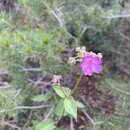Comprehensive Description
provided by North American Flora
Allionia decipiens Standley, sp. nov
Allionia divaricata Standley, Contr. U. S. Nat. Herb. 12: 342, in part. 1909. Not A. divaricata Rydb. 1902.
Stems solitary, or few, erect or decumbent, 3-8 dm. high, slender, simple or sparsely branched below the inflorescence, green, bifariously puberulent or glabrate, the internodes elongate, usually longer than the leaves; petioles slender, 0.2-3.5 cm. long, or the uppermost
leaves sessile, the blades lanceolate to linear, 2.5—12 cm. long, 2.5-10 or rarely 20 mm. wide, obtuse to attenuate at the base, narrowed to the obtuse or acute apex, entire, bright-green, usually ciliate but otherwise glabrous; inflorescence loosely cymose-paniculate, the branches slender, alternate, viscid-villous with short fulvous hairs; involucres usually crowded, on short slender peduncles, 4-5 mm. long at anthesis, 10-12 mm. broad in fruit, densely viscidvillous, the lobes ovate-oval, rounded or obtuse at the apex; flowers 3 in each involucre, the perianth 8-10 mm. long, deep purplish-red, sparsely short-pilose, the limb 5-lobed, the lobes retuse; fruit obovoid, 4.5 mm. long, olivaceous, minutely hirtellous, the angles smooth, the sides transverse-rugose; seed oval-obovoid, 2.5 mm. long, pale yellowish-brown.
Type collected in an oak thicket, Brazos Canyon, Rio Arriba County, New Mexico, August 24, 1914, P. C. Standley & H. C. Bollman 10743 (U. S. Nat. Herb. no. 689453).
Distribution: Mountain slopes, Arizona, New Mexico, and southern Colorado.
- bibliographic citation
- Paul Carpenter Standley. 1918. (CHENOPODIALES); ALLIONIACEAE. North American flora. vol 21(3). New York Botanical Garden, New York, NY
Comprehensive Description
provided by North American Flora
Allionia decipiens Standley, sp. nov
Allionia divaricata Standley, Contr. U. S. Nat. Herb. 12: 342, in part. 1909. Not A. divaricata Rydb. 1902.
Stems solitary or few, erect or decumbent, 3-8 dm. high, slender, simple or sparsely branched below the inflorescence, green, bifariously puberulent or glabrate, the internodes elongate, usually longer than the leaves; petioles slender, 0.2-3.5 cm. long, or the uppermost leaves sessile, the blades lanceolate to linear, 2.5-12 cm. long, 2.5-10 or rarely 20 mm. wide, obtuse to attenuate at the base, narrowed to the obtuse or acute apex, entire, bright-green, usually ciliate but otherwise glabrous; inflorescence loosely cymose-paniculate, the branches slender, alternate, viscid-villous with short fulvous hairs; involucres usually crowded, on short slender peduncles, 4-5 mm. long at anthesis, 10-12 mm. broad in fruit, densely viscidvillous, the lobes ovate-oval, rounded or obtuse at the apex; flowers 3 in each involucre, the perianth 8-10 mm. long, deep purplish-red, sparsely short-pilose, the limb 5-lobed, the lobes retuse; fruit obovoid, 4.5 mm. long, olivaceous, minutely hirtellous, the angles smooth, the sides transverse-rugose; seed oval-obovoid, 2.5 mm. long, pale yellowish-brown.
Type collected in an oak thicket, Brazos Canyon, Rio Arriba County, New Mexico, August 24, 1914, P. C. Standley &* H. C. Bollman 10743 (U. S. Nat. Herb. no. 689453).
Distribution: Mountain slopes, Arizona, New Mexico, and southern Colorado.
- bibliographic citation
- Paul Carpenter Standley. 1918. (CHENOPODIALES); ALLIONIACEAE. North American flora. vol 21(3). New York Botanical Garden, New York, NY

